I have to be honest. I do not love mushrooms. I sometimes feel like my residency in Southern Chester County would be better filled with someone who loves to cook our local crop to perfection. But alas, my family and I live in the heart of mushroom country. So much so that my husband and I sometimes awaken in the dead of night gasping, “The mushrooms … close the windows!”
One of our neighbors, Michael Guizzetti Jr., is a mushroom farmer and, over the past few years of getting to know him and his family, we have asked the occasional question, wanting the inside scoop on how it all works. They offered a farm tour to us and other neighbors to clear the air on the topic, and so became our recent family field trip.
As an Assistant Grower at Guizzetti Mushroom Farm, Inc., in Landenberg, Guizzetti has worked in the family business since 1990, when he was just a pre-teen. His great grandmother started the business in the 1930s after losing her husband and relocating to live with family. Although it was expected that Guizzetti would follow in his family’s footsteps, he said he didn’t mind and noted that having a family business certainly has its advantages.
As we gathered at the front of the farm, Guizzetti pointed to various homes scattered within sight. “My grandparents live there; my dad was born in that house, I was born in that house and Lily [his young daughter] was born in that house.” Witnessing the rich family history involved with this farm, I was already feeling less hassled with the infamous aroma.
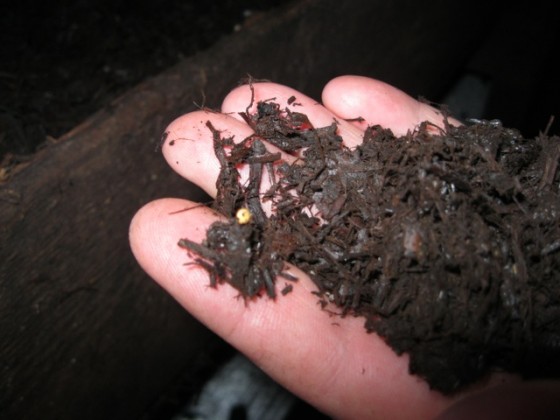 We started our tour checking out the compost rows, neatly lining an area approximately the size of a football field. According to Guizzetti, the proximity of the raw materials is what makes Southern Chester County an ideal location for mushroom farming, with most of the horse manure coming from within 100 miles. Lucky us!
We started our tour checking out the compost rows, neatly lining an area approximately the size of a football field. According to Guizzetti, the proximity of the raw materials is what makes Southern Chester County an ideal location for mushroom farming, with most of the horse manure coming from within 100 miles. Lucky us!
The compost is made on-site, taking 21–28 days from start to finish. Raw materials include the nutrients: horse manure, straw, corn cob, gypsum, cocoa shells and chicken manure. The hay is blended with the nutrients and by the end of the composting process the black soil is ready to be pumped via a conveyor system into the mushroom house. Amazingly, a single mushroom house can hold 225 cubic yards of soil throughout six layers of growing beds set up like vertical bunks with gangways between each section. I was already impressed with the amount of preparation required in readying the soil; I had no idea the processes that followed.
 After checking out an empty house, we were able to tour several houses in various stages of growth. Guizzetti told us that once the house is full of soil, a two-week cook-out process is conducted to pasteurize the soil. This involves using steam to get the soil and air temperatures to certain levels, followed by flushing the house with fresh air.
After checking out an empty house, we were able to tour several houses in various stages of growth. Guizzetti told us that once the house is full of soil, a two-week cook-out process is conducted to pasteurize the soil. This involves using steam to get the soil and air temperatures to certain levels, followed by flushing the house with fresh air.
The first house was a steamy 130 degrees—dark and incredibly potent smelling, it was so humid that our flashlights steamed up, throwing light only a few blurry feet. The damp soil packed each section of the cypress-lined wood beds, four or so sections across and six levels up. To administer to the various needs of the mushroom house during these processes, the workers must climb ladder-like staircases and walk along narrow gangways to get to the different levels and work in the pitch dark using headlamps until it is time to pick the mushrooms.
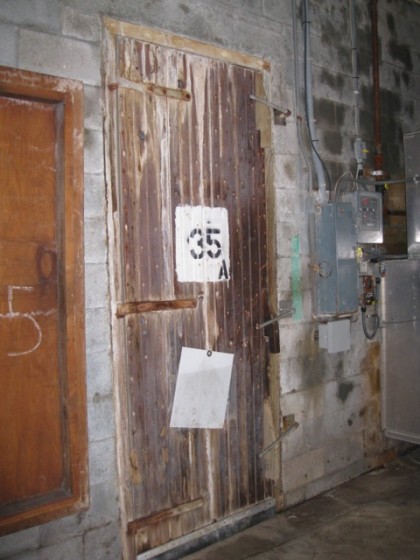 In the next stage of the process, the soil temperature is 120 degrees, continuing to drop to the ideal growing-temperature range of 76 to 82 degrees. The Guizzetti Mushroom Farm grows white mushrooms only, which is determined in the type of spawn grain inserted into the soil to feed the mushroom spores. When we visited the house in this stage, the air temperature was nice and cool and everyone wandered the rows using their flashlights to peek in on the progress of the soil. Through the pasteurization process, the smell had gone from a strong manure odor to an almost sweet, organic scent. In six days, the spawn grain grows to the point that it can start to feed the mushroom spores. The spawn grain grows throughout the soil, and in 15-16 days the entire top of the soil has a tough white covering that looks like frost. At this point, a layer of peat moss is added and the mushrooms begin to grow.
In the next stage of the process, the soil temperature is 120 degrees, continuing to drop to the ideal growing-temperature range of 76 to 82 degrees. The Guizzetti Mushroom Farm grows white mushrooms only, which is determined in the type of spawn grain inserted into the soil to feed the mushroom spores. When we visited the house in this stage, the air temperature was nice and cool and everyone wandered the rows using their flashlights to peek in on the progress of the soil. Through the pasteurization process, the smell had gone from a strong manure odor to an almost sweet, organic scent. In six days, the spawn grain grows to the point that it can start to feed the mushroom spores. The spawn grain grows throughout the soil, and in 15-16 days the entire top of the soil has a tough white covering that looks like frost. At this point, a layer of peat moss is added and the mushrooms begin to grow.
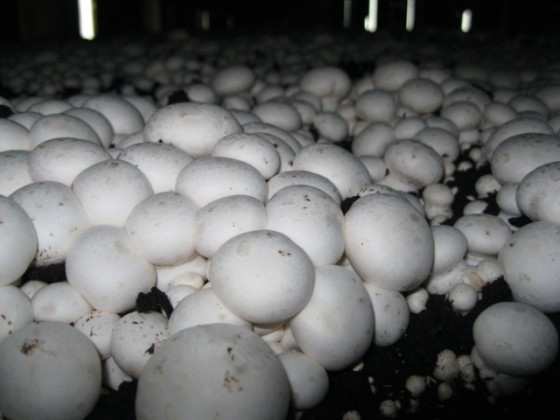 When we visited the house in the final stage—picking—it was amazing! In a little over an hour, we had walked through seven weeks of the growing process. It was overwhelming and impressive and I felt a great sense of appreciation for all the work that goes into cultivating this crop. The house ripe for picking had hanging lights, a sharp contrast to all the dark houses we had been inside. It was full of peppy white mushroom caps poking through the soil. Row after row of soil beds proudly boasted the beautiful bright white mushrooms contrasted against the deep black soil. Kids and adults alike reached into the beds, snapped fresh mushrooms from the soil and popped them in their mouths. My son and I tried one and although it was smooth and soft and fairly mild in taste, I was happier to delight in the view and watching everyone else sample.
When we visited the house in the final stage—picking—it was amazing! In a little over an hour, we had walked through seven weeks of the growing process. It was overwhelming and impressive and I felt a great sense of appreciation for all the work that goes into cultivating this crop. The house ripe for picking had hanging lights, a sharp contrast to all the dark houses we had been inside. It was full of peppy white mushroom caps poking through the soil. Row after row of soil beds proudly boasted the beautiful bright white mushrooms contrasted against the deep black soil. Kids and adults alike reached into the beds, snapped fresh mushrooms from the soil and popped them in their mouths. My son and I tried one and although it was smooth and soft and fairly mild in taste, I was happier to delight in the view and watching everyone else sample.
Guizzetti explained that white mushrooms emerge in three “breaks”—each break involves four to seven days of picking. Once the mushrooms are all picked, the soil is taken out of the house and can be used for mix in mulch, soil, etc.
From the start of this journey as compost to the final product, the cultivation of a mushroom crop encompasses almost three months with nearly constant adjustments and attention from basic visual assessments to high-tech electronic thermostats and air-flow systems. Guizzetti said that technology has made the growing process easier and allows them to grow mushrooms year round; before air conditioning, the growing season would end in the spring.
We each left our field trip with a box of fresh mushrooms and a cookbook. My husband sautéed mushrooms throughout the week and, wouldn’t you know, I ate them and didn’t totally dislike them. Perhaps there is hope for me yet! I certainly walked away with a great appreciation for the hard work that goes into maintaining the lead agriculture for our county. I also have a renewed patience and appreciation for the wafting winds, although I think I’ll still close the windows.
Find Guizzetti Mushroom Farm Inc. at 722 Penn Green Road in Landenberg. They are reachable by phone at (610) 268-3186.
Photos credited to Erin Phelps.
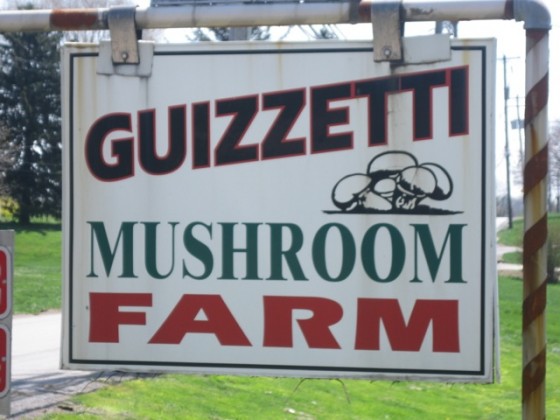
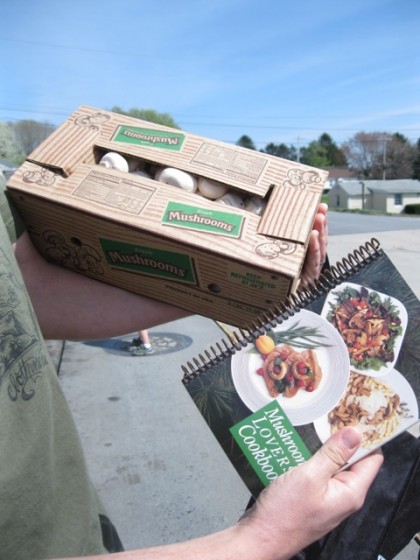




One Comment